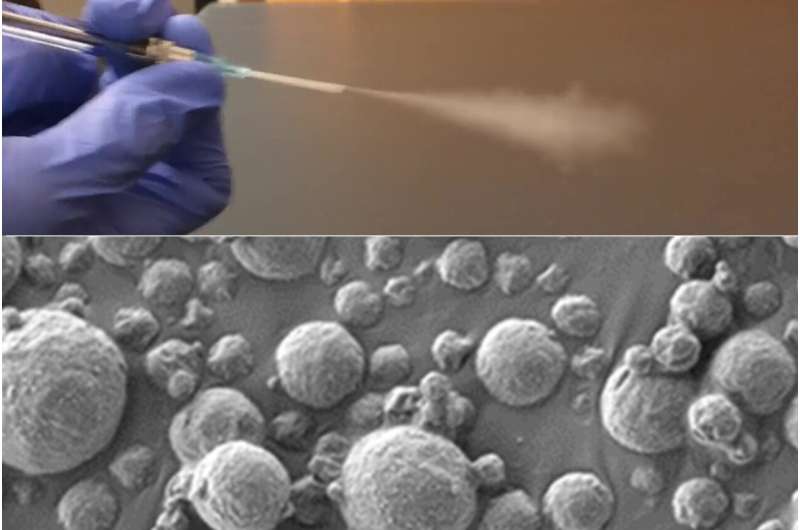New technology: Early detection of lung cancer possible with inhalable sensors

January 5, 2024
Undergoing a rigorous editorial process, this article's credibility has been ensured by utilizing certain key verification methods.
- Fact-checked
- Reviewed by peers
- Sourced from a reputable provider
- Proofread
And also evaluated by the Massachusetts Institute of Technology
A new technology developed at MIT has the potential to simplify the process of lung cancer diagnosis. This is achieved by simply inhaling nanoparticle sensors and running a urine test to indicate the presence of a tumor.
The diagnosis is based on nanosensors, which can be administered via an inhaler or nebulizer. When these sensors come in contact with proteins associated with cancer in the lungs, they create a signal that is present in urine. This signal can be identified using a basic paper test strip.
This new technique could augment - or even replace - the current standard for diagnosing lung cancer which is low-dose computed tomography (CT). It would be particularly beneficial for low- and middle-income countries where CT scanners are in short supply, according to the scientists involved.
Considering global cancer statistics, Sangeeta Bhatia, the senior author of the study and professor at MIT, mentions the importance of this technology, especially in regions where cancers like lung cancer are prevalent due to pollution and smoking.
The authors of the study, Qian Zhong and Edward Tan, aim to identify lung cancer in heavy smokers over the age of 50, a target group at risk where CT scans may not be sufficient or available.
Over the years, Bhatia has contributed towards developing nanosensors for detecting cancers and a host of other diseases. In this study, the team explored the potential of nanosensors as an affordable alternative to expensive CT screenings for lung cancer.
The sensors are made up of polymer nanoparticles coated with a reporter like a DNA barcode that gets detached from the particle when it meets enzymes, called proteases, that are usually overactive in tumors. These reporters gradually accumulate in the urine and are then excreted from the body.
The latest versions of these sensors can be inhaled, making them easy to use in areas with limited resources. They're designed as a solution to be aerosolized with a nebulizer or as a dry powder to be administered using an inhaler.
Once inhaled, these particles are absorbed into lung tissue where they come into contact with any potentially present proteases. These enzymes associated with cancer cut through proteins of the extracellular matrix, helping cancer cells migrate from their original locations. The DNA barcodes are released from the sensors and then excreted in the urine.
Previously versions of this technology required mass spectrometry to analyze the urine sample and detect DNA barcodes, a process that may not be feasible in low-resource areas. So, in the new technology, they utilize a paper test strip to detect the barcodes, which, depending on the type of barcode, indicates the presence of different proteases. No pre-processing of the urine sample is needed and results are available within 20 minutes.
'We were really pushing this assay to be point-of-care available in a low-resource setting, so the idea was to not do any sample processing, not do any amplification, just to be able to put the sample right on the paper and read it out in 20 minutes,' Bhatia says.
The researchers tested their diagnostic system in mice that are genetically engineered to develop lung tumors similar to those seen in humans. The sensors were administered 7.5 weeks after the tumors started to form, a time point that would likely correlate with stage 1 or 2 cancer in humans.
In their first set of experiments in the mice, the researchers measured the levels of 20 different sensors designed to detect different proteases. Using a machine learning algorithm to analyze those results, the researchers identified a combination of just four sensors that was predicted to give accurate diagnostic results. They then tested that combination in the mouse model and found that it could accurately detect early-stage lung tumors.
For use in humans, it's possible that more sensors might be needed to make an accurate diagnosis, but that could be achieved by using multiple paper strips, each of which detects four different DNA barcodes, the researchers say.
The researchers now plan to analyze human biopsy samples to see if the sensor panels they are using would also work to detect human cancers. In the longer term, they hope to perform clinical trials in human patients. A company called Sunbird Bio has already run Phase I trials on a similar sensor developed by Bhatia's lab, for use in diagnosing liver cancer and a form of hepatitis known as nonalcoholic steatohepatitis (NASH).
In parts of the world where there is limited access to CT scanning, this technology could offer a dramatic improvement in lung cancer screening, especially since the results can be obtained during a single visit.
'The idea would be you come in and then you get an answer about whether you need a follow-up test or not, and we could get patients who have early lesions into the system so that they could get curative surgery or lifesaving medicines,' Bhatia says.
Provided by Massachusetts Institute of Technology
This story is republished courtesy of MIT News (web.mit.edu/newsoffice/), a popular site that covers news about MIT research, innovation and teaching.




